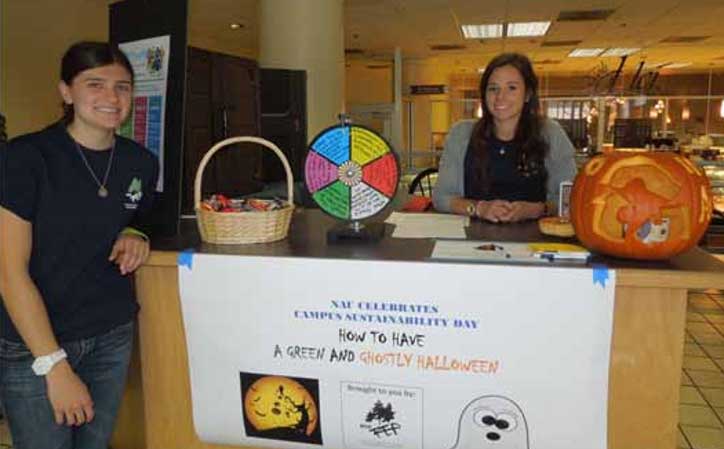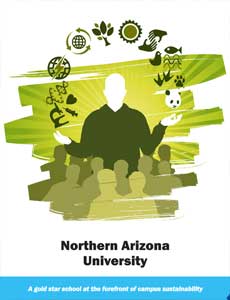A gold star school at the forefront of campus sustainability
Northern Arizona University (NAU) is a public university located in Flagstaff, Arizona. It has a student population of over 20,000, with over 7,000 living on campus. The school offers 87 bachelor degree programs, 48 master’s degree programs, and 10 doctoral degree programs, along with 38 undergraduate and 26 graduate certificates. Like many colleges and universities, today, NAU has numerous programs and curricula devoted to environmental science and awareness. The school’s Office of Sustainability was instituted in 2007. Its mission is to provide a living laboratory where students, faculty, and staff can participate in the development of social equity, economic stability, and environmental stewardship in seven key areas: water, recycling and waste minimization, transportation, operations, procurement, energy and climate change, and academics and research.
All seven of those key initiatives are part of NAU’s Sustainability Action Plan, originally created in 2010, and updated and revised in 2015. The goal of the Plan is to meet 25 percent of each section’s actions by this year, 50 percent by 2016, 70 percent by 2017, 80 percent by 2018, 90 percent by 2019, and 100 percent by 2020. Some of NAU’s additional sustainable accomplishments and projects include: the development and implementation of 29 undergraduate and 13 graduate academic degree programs in the environment and sustainability, 79 academic courses in sustainability and 125 academic courses related to sustainability; an 18 million dollar investment in a campus-wide, energy efficiency retrofit and conservation program; a million dollar investment in 138 dual “Big Belly” outdoor recycling and trash receptacles; the initial movement towards a new water irrigation system that will reduce landscaping water use by approximately 35 percent; and LEED certification of 15 campus buildings by the end of 2016. (Developed by the U.S. Green Building Council, LEED stands for Leadership in Energy & Environmental Design, a green building certification program that recognizes best-in-class building strategies and practices. To receive LEED certification, building projects satisfy prerequisites and earn points to achieve different levels of certification – Silver, Gold, and Platinum.)
Key to NAU’s sustainability objectives is inculcating in its students – especially those who live on-campus – behaviors that will help conserve energy in residence halls and buildings. Cori Cusker is NAU’s Housing and Residence Life Sustainability Coordinator. She outlines her responsibilities in carrying out that aim: “over 7,000 students live on campus and that’s a pretty big impact. My charge is to teach them how to adopt conservation-focused behaviors that they can use on campus and then later in life. I do that in a variety of different ways. One that I focus on is the Eco-Rep program, a group of peer educators modeled after a national model. My students are assigned to a hall, preferably the one they live in. We meet weekly and talk about a variety of topics. I focus a lot on conservation and try and give them a holistic perspective of what sustainability is – looking at the social and community aspect of it, consumerism, but also your basic behaviors of waste minimization and water and energy conservation.
I take a quasi-academic approach with them. We have a manual about different topics. The students actually learn a lot. There’s a lot of personal growth and development that happens through participating in the Eco-Rep program. Even the students who are really knowledgeable and excited about environmental issues when they get here learn something new every year.”
Ellen Vaughan is the Manager of the NAU Sustainability Office. In addition to having led the rewriting of NAU’s Sustainability Action Plan, she oversees Green NAU, the school’s centralized, online information center, a one-stop-shop for all information related to sustainability at the university. Her Office also coordinates the many diverse programs that help promote sustainability concepts within the confines of the NAU campus. For example, the Environmental Caucus facilitates creative and strategic communication to advance the institutional commitment to sustainability and to promote education, research, and collaboration on the environment. Green Jacks, also known as the Student Environmental Caucus, seeks to create a culture of sustainability on campus via extra-curricular initiatives and programs.
But Vaughan also stresses the activities that take the school’s sustainability programs beyond the campus and into the broader community: “We have quarterly meeting with the sustainability leaders at the city and county levels to try and see if we can have similar messaging or collaborate on purchasing,” she relates. “We also have student action groups’ whose main purpose is to go out into the community and help create student gardens, participate in public achievement, teach resource efficiency, etc. For example, we give a lot of our compost to the community gardens, so we’re always looking at ways to share resources.” CRAFTS – Civic Re-engagement for Arizona Families, Transitions and Sustainability – is a campus program whose aim is to foster sustainable communities through engaged learning, community partnerships, and action research with NAU.
But fostering sustainability consciousness at NAU is not restricted to its students. Avi Henn is the Program Coordinator for the campus’ Energy Mentors Program. He outlines the program’s focus and genesis: “We recruit volunteer faculty and staff to go through training and become part of a larger community that mentors their peers in specific behaviors that save energy. This whole project came about as the brainchild of a lower-level administrator – the Director of Utilities – but at the same time, the initial phase of this project was paid for by student money.” In addition, the university also has a Coordinating Committee for Campus Sustainability, or CoCoSus, which is made up of high level members of the school’s administration and faculty. Its purpose is to facilitate inter-departmental sustainability initiatives and further the university’s progress toward the goal of carbon neutrality.
Another key objective of NAU’s sustainability programs is to quantify the savings that investments in green initiatives can accrue. According to Henn, the school’s years-long, $18 million retrofit project that covered about 80 percent of the campus, targeting lighting (since 2012, 12,000 light fixtures have been changed out to CFL or LED lighting), water, and natural gas, is projected to save the school some $1.5 million per year and $40 million over the life span of the project. But those numbers are only projections based on models. Megan Burke, NAU’s LEED Coordinator, discusses the school’s aim to record specific data: “We’re starting to lay the foundation down to get more quantifiable information. We started a lot of tracking programs for things like waste, or purchasing, and cleaning – things of that nature – so we are starting to get more programs together so we can actually show hard numbers; this is what we’ve saved, this is a year’s worth of data.”
According to Burke, the Cline Library, which is slated for LEED certification in 2016, will provide that type of detailed information. “For the Cline Library, we will be using energy data to see if the cost savings that were estimated match up with what the meters currently show what we’re saving based on the retrofits that that building received,” she says. Cusker adds: “It’s a slow process. Every institution wants to quantify and track everything and it may take another four to five years to really have a kind of system in place that’s successful and that allows us to do that.”
NAU’s comprehensive sustainability programs and initiatives recently earned it a ranking of 37th Greenest School in America from Best Colleges.com, based on its Gold Star rating from The Association for the Advancement of Sustainability in Higher Education (AASHE). Cusker elaborates upon the school’s high profile: “What makes us stand out is that we really are trying to look at sustainability in all areas – from how we operate as a campus, what we role-model for the next generation of students, and the many sorts of academic and extra-curricular opportunities they have no matter what their major is. NAU is perhaps not at the top of the list for prestigious academic institutions, but we have some really talented faculty doing really great things around environmental and sustainability research and that strengthens the holistic approach that we take here. And we have a pretty diverse group of staff – Campus Dining, Housing and Residence Life, Facility Services; we have a very good working partnership and it helps us move things along and do some really cool things.”
And when it comes to green initiatives that foster sustainability and conserve the environment, “cool things” is precisely what we need.
______________________________________
AT A GLANCE
WHO: Northern Arizona University
WHAT: A public university, first established in 1899
WHERE: Main campus is located in Flagstaff, AZ
WEBSITE: www.nau.edu


